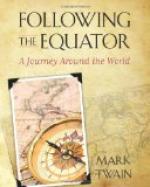One may take his choice. They are all the same price. One fact is sure: he keeps his prominence and a vast following, no matter what he does. He “deceives” the Duke of Fife—it is the Duke’s word—but that does not destroy the Duke’s loyalty to him. He tricks the Reformers into immense trouble with his Raid, but the most of them believe he meant well. He weeps over the harshly—taxed Johannesburgers and makes them his friends; at the same time he taxes his Charter-settlers 50 per cent., and so wins their affection and their confidence that they are squelched with despair at every rumor that the Charter is to be annulled. He raids and robs and slays and enslaves the Matabele and gets worlds of Charter-Christian applause for it. He has beguiled England into buying Charter waste paper for Bank of England notes, ton for ton, and the ravished still burn incense to him as the Eventual God of Plenty. He has done everything he could think of to pull himself down to the ground; he has done more than enough to pull sixteen common-run great men down; yet there he stands, to this day, upon his dizzy summit under the dome of the sky, an apparent permanency, the marvel of the time, the mystery of the age, an Archangel with wings to half the world, Satan with a tail to the other half.
I admire him, I frankly confess it; and when his time comes I shall buy a piece of the rope for a keepsake.
CONCLUSION.
I have traveled more than anyone else, and I have
noticed that even the angels speak English with an
accent.
—Pudd’nhead
Wilson’s New Calendar.
I saw Table Rock, anyway—a majestic pile. It is 3,000 feet high. It is also 17,000 feet high. These figures may be relied upon. I got them in Cape Town from the two best-informed citizens, men who had made Table Rock the study of their lives. And I saw Table Bay, so named for its levelness. I saw the Castle—built by the Dutch East India Company three hundred years ago—where the Commanding General lives; I saw St. Simon’s Bay, where the Admiral lives. I saw the Government, also the Parliament, where they quarreled in two languages when I was there, and agreed in none. I saw the club. I saw and explored the beautiful sea-girt drives that wind about the mountains and through the paradise where the villas are: Also I saw some of the fine old Dutch mansions, pleasant homes of the early times, pleasant homes to-day, and enjoyed the privilege of their hospitalities.
And just before I sailed I saw in one of them a quaint old picture which was a link in a curious romance—a picture of a pale, intellectual young man in a pink coat with a high black collar. It was a portrait of Dr. James Barry, a military surgeon who came out to the Cape fifty years ago with his regiment. He was a wild young fellow, and was guilty of various kinds of misbehavior. He was several times reported to headquarters in England, and it was in each case expected that orders would come out to deal with him promptly and severely, but for some mysterious reason no orders of any kind ever came back—nothing came but just an impressive silence. This made him an imposing and uncanny wonder to the town.




